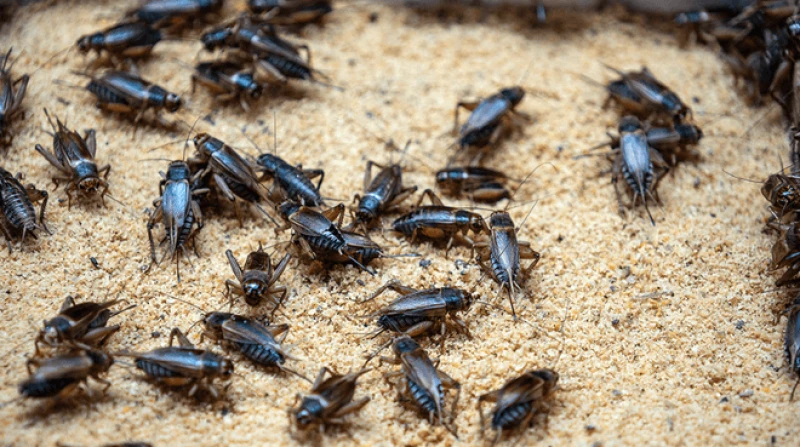Changing livestock diets: Here’s how crickets will help address agricultural sustainability challenges
Changing livestock diets: Here’s how crickets will help address agricultural sustainability challenges


During the late summer and early fall, you can hear the commotion in a customized, food-grade shipping container on the 165-acre property, where as many as 350,000 of the farm’s tiniest residents can’t contain their ruckus. The noisemakers are crickets — specifically adult males wooing mates — and they (and their potential sweethearts) are being raised expressly to feed the livestock that Thorpe Farms’ owner, Cory Priest, also raises.
They are part of a uniquely hyperlocal food chain: Priest also grows vegetables, and the scraps from his veggie patch feed the crickets, which, once they mature, are gobbled up by Priest’s chickens and turkeys. The crickets, of course, also lay eggs, guaranteeing a more-or-less perpetual food supply. When baby crickets reach maturity, they are flash-frozen, then later thawed and fed to Priest’s chickens.
What makes the process even more unusual — and holds promise for many other farmers — is that this circle of life hinges on a high-tech system. The food container was customized by the Ontario startup Bug Mars and is outfitted with incubators and habitats. Eight separate cameras, as well as other sensors, are embedded within the container and collect data such as temperature, air quality, cricket movement, pest invasions. That data is sent to a tablet where Bug Mars’ proprietary platform processes it for Priest, who uses the knowledge to optimize the health and yield of his crop.

 | Videos | More... |

Video: Nuclear energy will destroy us? Global warming is an existential threat? Chemicals are massacring bees? Donate to the Green Industrial Complex!
 | Bees & Pollinators | More... |

GLP podcast: Science journalism is a mess. Here’s how to fix it

Mosquito massacre: Can we safely tackle malaria with a CRISPR gene drive?

Are we facing an ‘Insect Apocalypse’ caused by ‘intensive, industrial’ farming and agricultural chemicals? The media say yes; Science says ‘no’
 | Infographics | More... |

Infographic: Global regulatory and health research agencies on whether glyphosate causes cancer
 | GMO FAQs | More... |

Why is there controversy over GMO foods but not GMO drugs?

How are GMOs labeled around the world?

How does genetic engineering differ from conventional breeding?
 | GLP Profiles | More... |

Alex Jones: Right-wing conspiracy theorist stokes fear of GMOs, pesticides to sell ‘health supplements’




 Viewpoint — Fact checking MAHA mythmakers: How wellness influencers and RFK, Jr. undermine American science and health
Viewpoint — Fact checking MAHA mythmakers: How wellness influencers and RFK, Jr. undermine American science and health Viewpoint: Video — Big Solar is gobbling up productive agricultural land and hurting farmers yet providing little energy or sustainabilty gains
Viewpoint: Video — Big Solar is gobbling up productive agricultural land and hurting farmers yet providing little energy or sustainabilty gains Fighting deforestation with CO2: Biotechnology breakthrough creates sustainable palm oil alternative for cosmetics
Fighting deforestation with CO2: Biotechnology breakthrough creates sustainable palm oil alternative for cosmetics Trust issues: What happens when therapists use ChatGPT?
Trust issues: What happens when therapists use ChatGPT? 30-year-old tomato line shows genetic resistance to devastating virus
30-year-old tomato line shows genetic resistance to devastating virus California, Washington, Oregon forge immunization alliance to safeguard vaccine access against federal undermining
California, Washington, Oregon forge immunization alliance to safeguard vaccine access against federal undermining The free-range chicken dilemma: Better for birds, but with substantial costs
The free-range chicken dilemma: Better for birds, but with substantial costs ‘You have to treat the brain first’: Rethinking chronic pain with Sanjay Gupta
‘You have to treat the brain first’: Rethinking chronic pain with Sanjay Gupta
